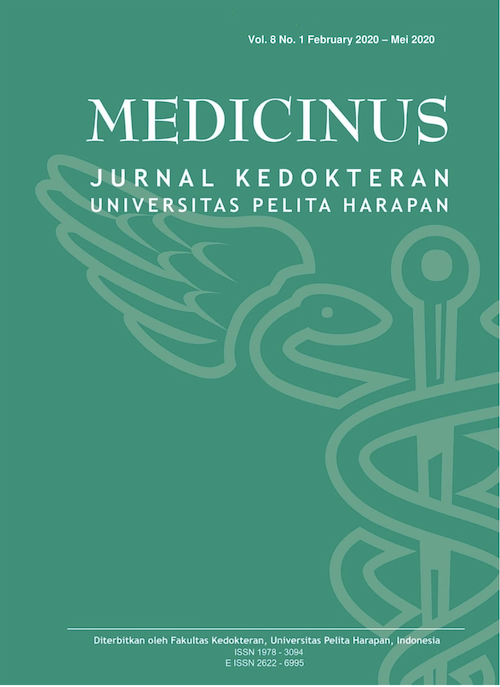Challenge as Physician to Diagnose Pediatric Patient with Laryngopharyngeal Reflux: A case report and literature review
DOI:
https://doi.org/10.19166/med.v8i1.3121Keywords:
Fiber-optic laryngoscopy, laryngopharyngeal reflux, pediatric, proton pump inhibitor, pneumonia, stridorAbstract
Background : Laryngopharyngeal reflux (LPR) is the reflux of backflow of gastric acid or refluxate that usually affects the throat and laryngopharynx. Many physicians are unable to differentiate between pediatric LPR with pneumonia. Laryngopharyngeal reflux needs to be widely known and understood by a physician because there are relationships between upper and lower airway disease. In pediatric, LPR may also contribute to many problems in the respiratory tract, the clinical manifestation of pediatric LPR, and remains a challenge for physicians.
Objective : To emphasize the new diagnostic symptoms and signs instrument for pediatric LPR using a fiber-optic laryngoscope, also to remind the correlation between the upper and lower respiratory tract and factors which contribute to pediatric airway.
Case : A case of a 21-month-old girl with sudden onset of hoarseness, stridor, and wheezing was diagnosed with pneumonia, further investigation showed reflux symptoms, vocal cord abnormalities, and subglottic edema that suggest LPR was the final diagnosis.
Conclusion : Pediatric LPR may be difficult to diagnose, there are many differential diagnosis, symptoms, and signs that may occur. The new diagnostic instrument can be used for diagnosing pediatric LPR, it is feasible and applicable in daily practice. Laryngopharyngeal reflux needs to be understood and considered as a differential diagnosis for coughing, hoarseness, in children despite the diagnosis challenge.
References
1. Swain SK, Choudhury J. Experience with the management of pediatric laryngopharyngeal reflux in an Indian teaching hospital. J Clin Sci. 2020;17(3):61-5.
https://doi.org/10.4103/jcls.jcls_38_19
2. Ricket SM, B.Zur K. Disorders of the Pediatric Voice. In: Pediatric Otolaryngology Principles and Practice Pathways. Thieme Medical Publisher; 2012. p. 690.
3. Sowa L, Schimdt H, Gerber ME. Laryngopharyngeal Reflux. In: Multidisciplinary Management of Pediatric Voice and Swallowing Disorders. Springer Nature Switzerland; 2020. p. 227-38.
https://doi.org/10.1007/978-3-030-26191-7_23
4. Karyanta M, Satrowiyoto S, Wulandari DP. Prevalence Ratio of Otitis Media with Effusion in Laryngopharyngeal Reflux. Int J Otolaryngol. 2019;2019(November 2016):1-3.
https://doi.org/10.1155/2019/7460891
5. Kopka M, MaÅ‚ecka M, Stelmach I. Chronic cough as a symptom of laryngopharyngeal reflux ”” Two case reports. Adv Respir Med. 2016;85(1):29-32.
https://doi.org/10.5603/PiAP.a2015.0082
6. Al-Shamrani A, Bagais K, Alenazi A, Alqwaiee M, Al-Harbi AS. Wheezing in children: Approaches to diagnosis and management. Int J Pediatr Adolesc Med [Internet]. 2019;6(2):68-73. https://doi.org/10.1016/j.ijpam.2019.02.003
7. Hartnick CJ, Maturo SC. Airway Manifestation of Pediatric Gastrophageal Reflux Disease. In: Pediatric Otolaryngology Principles and Practice Pathways. Thieme Medical Publisher; 2012. p. 600-9.
8. Furuta GT, Liacouras CA, Collins MH, Gupta SK, Justinich C, Putnam PE, et al. Eosinophilic Esophagitis in Children and Adults: A Systematic Review and Consensus Recommendations for Diagnosis and Treatment. Sponsored by the American Gastroenterological Association (AGA) Institute and North American Society of Pediatric Gastroenterol. Gastroenterology. 2007;133(4):1342-63.
https://doi.org/10.1053/j.gastro.2007.08.017
9. Rosen R, Vandenplas Y, Singendonk M, Cabana M, Dilorenzo C, Gottrand F, et al. Pediatric Gastroesophageal Reflux Clinical Practice Guidelines: Joint Recommendations of the North American Society for Pediatric Gastroenterology, Hepatology, and Nutrition and the European Society for Pediatric Gastroenterology, Hepatology, and Nutritio. Vol. 66, Journal of Pediatric Gastroenterology and Nutrition. 2018. 516-554 p.
https://doi.org/10.1097/MPG.0000000000001889
10. Belafsky PC, Postma GN, Koufman JA. Laryngopharyngeal reflux symptoms improve before changes in physical findings. Laryngoscope. 2001;111(6):979-81.
https://doi.org/10.1097/00005537-200106000-00009
11. Ugras MK, Dogan M, Pata DYS, Ozkan F. Can the Reflux Finding Score and Reflux Symptom Index Be Used to Evaluate the Severity of Esophagitis in Children? J Voice [Internet]. 2019.
https://doi.org/10.1016/j.jvoice.2019.07.023
Downloads
Published
How to Cite
Issue
Section
License
Copyright (c) 2021 Niken Ageng Rizki

This work is licensed under a Creative Commons Attribution-ShareAlike 4.0 International License.
Authors who publish with this journal agree to the following terms:
1) Authors retain copyright and grant the journal right of first publication with the work simultaneously licensed under a Creative Commons Attribution License (CC-BY-SA 4.0) that allows others to share the work with an acknowledgement of the work's authorship and initial publication in this journal.
2) Authors are able to enter into separate, additional contractual arrangements for the non-exclusive distribution of the journal's published version of the work (e.g., post it to an institutional repository or publish it in a book), with an acknowledgement of its initial publication in this journal.
3) Authors are permitted and encouraged to post their work online (e.g., in institutional repositories or on their website). The final published PDF should be used and bibliographic details that credit the publication in this journal should be included.





